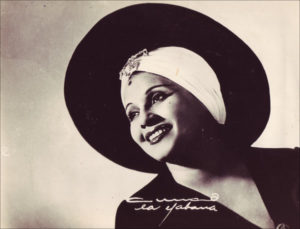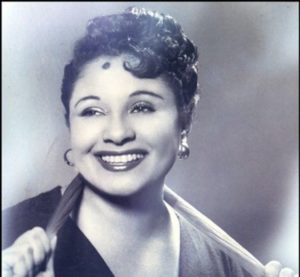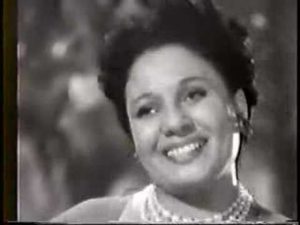 “BETTER THAT I SHUT UP, NOT SAY ANYTHING”. THE UNIQUE, RITA MONTANER.
“BETTER THAT I SHUT UP, NOT SAY ANYTHING”. THE UNIQUE, RITA MONTANER.
Rita Aurelia Montaner Facenda was born in Guanabacoa, in 1900. Her father is a distinguished doctor of the town, a well-planted and extremely kind gentleman, and the mother, a beautiful mulatto. They make up a well-off family, but not rich. The girl will study piano. He enrolled in the Peyrellade Conservatory, in Calzada de Reina, number 3, and later he studied singing with maestro Pablo Morales.
Evidence an extraordinary facility for music, his technique is unbeatable, can read a musical piece as a bird’s eye and interpret it on the piano at first reading. It also has a pleasant and well-stamped voice. He sings a cappella and does not require a prior intonation to do so. He loves to sing and when he does he wants the intimate and familiar room of his house to become, as if by magic, a great stage.
October 10, 1922 marks a milestone in our history. The radio in Cuba is inaugurated that day. At four in the afternoon, the notes of the National Anthem, played by Luis Casas Romero’s orchestra, give way to the speech of Alfredo Zayas, president of the Republic. He follows a solo violin and immediately Rita plays ‘Rosas y violetas’, by José Mauri, and ‘Presentimiento’, by Eduardo Sánchez de Fuentes. It is Mrs. Rita Montaner de Fernández, because five years before, with 17, the artist married the lawyer Alberto Fernández Macías, who will insist on accompanying her to all her concerts, just as before the father took her by the hand to the conservatory. Other marriages would come later. Marital relationships attributed or real. Like the musician Xavier Cugat, with whom he appeared on Broadway. Cugat states in his memoirs that he fell in love with Rita when they both studied at the Peyrellade Conservatory and that they got married in Mexico. Nobody believes it, but the lawyer Carlos Manuel Epifanio Palma and Valdés-Domínguez, director of the magazine Show, claimed to have seen the wedding certificate.
In Paris, Josephine Baker changed clothes behind the scenes to not miss the performance of the Cuban. Rita will sing with Al Jolson and alternate with María Luisa Landín, Libertad Lamarque, Pedro Vargas … She moves in the lyrical and the popular. It will be applauded in the cinema.
“BETTER THAT I SHUT UP…”
Very liked it was on the radio his character of Lengualisa who, with his spicy jokes, put his finger in the wound of national reality to conclude with an invariable “Better that I shut up, not say anything”, which nevertheless said it all. Yes, Rita knew how to be ductile and respectful in the scene. But among the people of the entertainment, Rita, foul-mouthed and malignant, was both admired and feared. Aggressiveness and irony did not escape even those who passed as their friends. In a world marked by an atrocious competition, he defended his place tooth and nail and was implacable with the chroniclers who criticized him; He went out to discuss them and covered them with the worst epithets. “It was tremendous when they cornered her, jumped to the jugular,” recalled Felix B. Caignet, the author of Fruits del Caney, Carabalí and I Hate You, of which Rita made real creations.
Television had it as one of its main figures. She was an artist, and there is also her greatness, which did not decline. He died in full ascension and this is credited by his latest performances, such as that Madame Flora of The Medium, by Menotti, who electrified those who saw her and who showed how much could still be expected of her if, 60 years ago, death did not It would have crossed his path. Rita Montaner died April 17 1958 in Havana, Cuba.
 “MEJOR QUE ME CALLE Y NO DIGA NADA”. LA ÚNICA, RITA MONTANER.
“MEJOR QUE ME CALLE Y NO DIGA NADA”. LA ÚNICA, RITA MONTANER.
Rita Aurelia Montaner Facenda nace en Guanabacoa, en 1900. Su padre es un médico distinguido de la villa, un caballero bien plantado y extremadamente amable, y la madre, una mulata bellísima. Conforman una familia acomodada, pero no rica. La niña estudiará piano. Matricularía en el Conservatorio Peyrellade, en la Calzada de Reina número 3, y más tarde hará estudios de canto con el maestro Pablo Morales.
Evidencia una facilidad extraordinaria para la música, su técnica es inmejorable, puede leer a vuelo de pájaro una pieza musical e interpretarla al piano en primera lectura. Tiene además una voz agradable y bien timbrada. Canta a capela y no requiere de entonación previa para hacerlo. Le gusta mucho cantar y cuando lo hace quiere que el salón íntimo y familiar de su casa se convierta como por arte de magia en un gran escenario.
El 10 de octubre de 1922 marca un hito en nuestra historia. Se inaugura ese día la radio en Cuba. A las cuatro de la tarde, las notas del Himno Nacional, interpretado por la orquesta de Luis Casas Romero, dan paso al discurso de Alfredo Zayas, presidente de la República. Sigue un solo de violín y enseguida Rita interpreta ‘Rosas y violetas’, de José Mauri, y ‘Presentimiento’, de Eduardo Sánchez de Fuentes. Es la señora Rita Montaner de Fernández, pues cinco años antes, con 17, la artista contrajo matrimonio con el abogado Alberto Fernández Macías, que insistirá en acompañarla a todos sus conciertos, así como antes el padre la llevó de la mano al conservatorio. Vendrían después otros matrimonios. Relaciones maritales atribuidas o reales. Como la del músico Xavier Cugat, con quien se presentó en Broadway. Afirma Cugat en sus memorias que se enamoró de Rita cuando ambos hacían estudios en el conservatorio Peyrellade y que contrajeron matrimonio en México. Nadie lo cree, pero el abogado Carlos Manuel Epifanio Palma y Valdés-Domínguez, director de la revista Show, afirmaba haber visto el certificado de la boda.
En París, Josephine Baker se cambiaba de ropa entre bastidores para no perderse la actuación de la cubana. Rita cantará con Al Jolson y alternará con María Luisa Landín, Libertad Lamarque, Pedro Vargas… Se mueve en lo lírico y en lo popular. Se hará aplaudir en el cine.
MEJOR QUE ME CALLE…
Muy gustado fue en la radio su personaje de ‘Lengualisa’ que, con sus bromas picantes, metía el dedo en la llaga de la realidad nacional para concluir con un invariable «Mejor que me calle, que no diga nada», que sin embargo lo decía todo. Si, Rita supo ser dúctil y respetuosa en la escena. Pero entre la gente de la farándula, Rita, deslenguada y malgeniosa, era tan admirada como temida. De su agresividad e ironía no se libraban siquiera aquellos que pasaban como sus amigos. En un mundo signado por una competencia atroz, defendió su lugar con uñas y dientes y fue implacable con los cronistas que le hacían críticas adversas; salía a discutirlos y los cubría con los peores epítetos. «Era tremenda cuando la acorralaban, saltaba a la yugular», recordaba Félix B. Caignet, el autor de Frutas del Caney, Carabalí y Te odio, de las que Rita hizo verdaderas creaciones.
La televisión la tuvo como una de sus figuras principales. Fue una artista, y ahí también está su grandeza, que no decayó. Murió en plena ascensión y así lo acreditan sus últimas actuaciones, como aquella madame Flora de La médium, de Menotti, que electrizó a los que la vieron y que evidenció lo mucho que aún podía esperarse de ella si, hace 60 años, la muerte no se hubiera cruzado en su camino. Rita Montaner murió el 17 de Abril de 1958 en la Habana, Cuba.
Agencies/Ciro Bianchi/OnCuba/Internet Photos/Excerpts/ Arnoldo Varona/ TheCubanHistory.com
THE CUBAN HISTORY, HOLLYWOOD.






